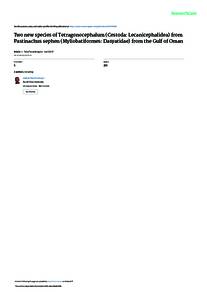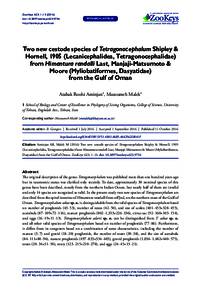Document
Two new species of tetragonocephalum (Cestoda : lecanicephalidea) from pastinachus sephen (Myliobatiformes : dasyatidae) from the Gulf of Oman.
Identifier
DOI: 10.14411/fp.2017.014
Source
Folia Parasitologica. v. 64, 14
Contributors
Malek, Masoumeh., Author
Country
Czech.
City
Prague.
Publisher
Czech Academy of Sciences.
Gregorian
2017-01-01
Language
English
English abstract
In the present study two new species of Tetragonocephalum Shipley et Hornell, 1905, T. mackenziei sp. n. and T. kazemii sp.n., are described from the spiral intestine of the cowtail stingray, Pastinachus sephen (Forsskål), from the northern coast of the Gulf ofOman. Tetragonocephalum mackenziei is distinguished from the 16 other valid species of Tetragonocephalum by a unique combinationof characteristics, i.e. sperm-filled seminal receptacle in immature proglottids, body length (7.7-17.5 mm), body width (213-288 μm),number of proglottids (34-49), number of testes (10-14), size of scolex (228-315 μm × 213-288 μm) and size of acetabula (56-73 μm× 61-75 μm). Tetragonocephalum kazemii is morphologically distinguishable from its valid congeners and T. mackenziei based ona combination of characteristics, including body length (28.8-36.6 mm), number of proglottids (50-65), number of testes (30-42), sizeof scolex (388-564 μm × 326-448 μm), size of acetabula (62-86 μm × 57-90 μm) and testes (25-39 × 21-32). This brings the totalnumber of validly described species of Tetragonocephalum to 18 and expands our knowledge of this diverse genus to now include theGulf of Oman, as well as Arafura Sea, northern Indian Ocean and western Pacific Ocean.
ISSN
0015-5683
Category
Journal articles


